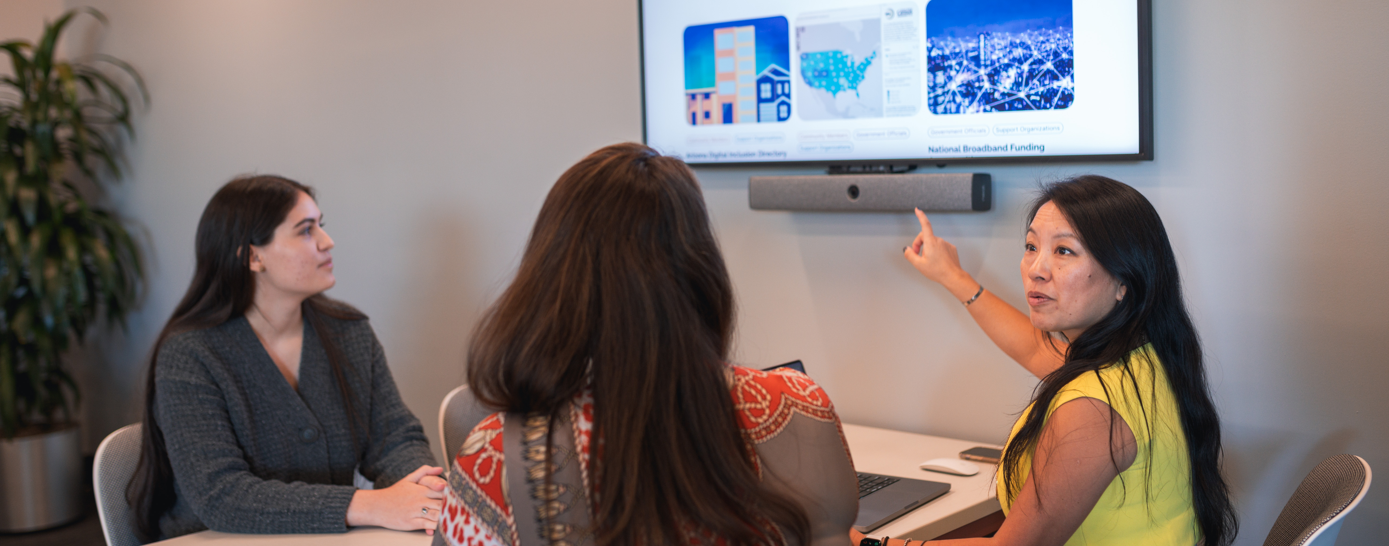The StoryMap explores the role of broadband as essential infrastructure — not just for technology, but for everyday life. Each story in the collection reveals a different angle of impact, including:
“A Guide for the Futurist Community” follows Gordon Fuller, a visually impaired artist and technologist whose accessibility-focused work reflects the deeper mission of digital inclusion.
“Empowering Mesa’s Workforce” showcases a partnership between Baltu Technologies and Mesa Public Library that’s helping train the next generation of fiber-optic technicians.
“Connecting for Care” tells the story of Parkinson’s patient Gregg Mossberger, who uses Zoom-based support groups to stay connected to therapy and community.
“Map with a Mission” spotlights ASU’s broadband mapping team, whose geospatial tools are helping cities and counties plan more equitable internet access.
All stories are authored by ASU students, many of whom are part of ASU’s Next Lab — a transdisciplinary space at ASU for immersive storytelling, game technologies and spatial computing. Students led the content creation, working directly with broadband and digital inclusion partners such as libraries and local nonprofit organizations, to collect stories from across Maricopa County. Each story is presented as a multimedia vignette, enhanced by custom maps, images and narrative storytelling.
“This project showcases the incredible potential of students when they're empowered with real-world challenges and trusted partnerships,” said Dan Munnerley, executive director of ASU’s Next Lab. “By harnessing the next technologies, we’re not just building solutions — we’re cultivating empathy, deepening understanding and inspiring meaningful action with our students leading the way.”
Mentorship behind the map
Behind the scenes, the students also benefited from the mentorship and guidance of Daniel Ennis and Ciera Parkhurst, who provided editorial feedback, professional development and training in key storytelling tools.
Ennis, who works on storytelling and design for MCBI at ASU, incorporated branding, design and editorial planning for digital publication. Parkhurst, a geospatial analyst, contributed custom interactive maps that add depth and context to the stories — such as a recent example visualizing global libraries that use AR technology. Together, they led workshops in tools like ArcGIS StoryMaps and multimedia sourcing, giving students the technical foundation to elevate their stories.
“Researching and talking to leaders in broadband has been one of my favorite parts of this work because I love learning how digital inclusion touches every aspect of life,” shared Shelby Cavanaugh Toft, ASU Next Lab’s student lead for the AZ-1 StoryMap. “What’s wonderful is realizing that you don’t have to devote your whole life to broadband to be part of this movement — you just have to believe in a better future, be creative and work hard to make change.”
Bridging data and lived experience
Part of what makes the “Broadband Stories from the Arizona Community” project so distinctive is its ability to humanize broadband data. Rather than presenting only speeds and service maps, the StoryMap pairs infrastructure details with lived experience — spotlighting community anchor institutions like schools, libraries and healthcare centers.
The effort aligns with MCBI’s broader goal to close the digital divide through three focus areas: mapping, infrastructure and digital equity. Since launching in 2022 with federal funding from the American Rescue Plan, the initiative has deployed thousands of devices, connected rural communities to high-speed internet, and helped more than 28,000 residents receive one-on-one digital navigation support. The AZ-1 portal, where the StoryMap is hosted, acts as a central hub for broadband data, planning tools and community resources.
“We’re proud that the work of our students reflects the real stories and voices of Arizona communities,” said Kelly Chung Mukherjee, program director for ASU’s MCBI. “It shows that infrastructure isn’t just about wires and routers — it’s about people.”

